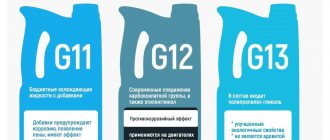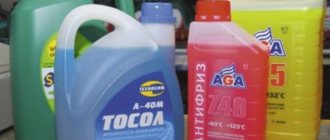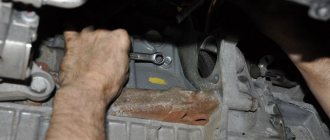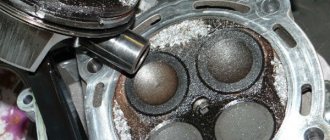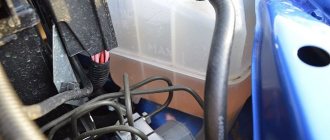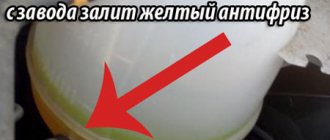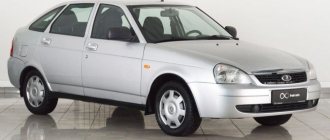Beginning car owners of the domestic automobile industry, learning the basics of car ownership, often ask various questions about servicing and repairing VAZs. One of the most frequently asked questions regarding the cooling system: which is better - Antifreeze or antifreeze for VAZ?
The question is quite interesting and is asked often, especially from owners who purchased a car, but were unable to get a clear answer from the former owner as to what was poured into the cooling system.
And before the winter period, when car preparation is required, this question comes up and makes you think. Let's try to figure it out.
How can I find out what kind of coolant was filled in at the factory?
In the vast majority of cases, it is very easy to find out the brand of antifreeze that was initially poured - just look at the sticker placed on the tank. This sticker always indicates in large letters the liquid with which the system was filled (and which it is recommended to add as needed).
In the vast majority of VAZ 2114 cars, the liquid filled at the factory is either Felix TC-40, produced in Dzerzhinsk, or CoolStream Standart 40, produced in Klimovsk. They can also be distinguished by color.
The first is bright green, the second is either green-yellow or faint green, in both cases there is slight fluorescence. Both of these liquids are antifreeze (belonging to class G11), and they can only be mixed with other liquids from this class.
Antifreeze FELIX
Many people believe that Antifreeze is much worse in quality than antifreeze, so they cannot be mixed. This is incorrect - the reason lies not in the quality or acidity of the medium, but in the very different densities of these two liquids.
If it is not intended to replace the coolant with a liquid of a different category (for example, antifreeze for antifreeze), then you can add it without draining the entire cooling system. Otherwise, this operation will be strictly necessary.
Lada Vesta: what kind of antifreeze is filled in from the factory?
From the factory, Sintec Antifreeze Lux G12 antifreeze is poured into the Lada Vesta car. It complies with TU 2422-047-51140047-2007. Antifreeze is red in color and is produced by Obninskorgsintez JSC in the city of Obninsk. Products of this brand are produced in volumes of 1, 3, 5, 10, 20 and 220 kg.
To order online you can use the following article numbers:
1kg - 613500 3kg - 990464 5kg - 614500 10kg - 756665 20l - 990470
And now a few words about the antifreeze itself. Sintec Antifreeze Lux G12 is the latest carboxylate antifreeze based on an aqueous solution of glycol and organic additives. Does not contain nitrites, nitrates, amines, phosphates, borates and silicates. Since 2011, this product was chosen as the main one for the first refueling of LADA cars at the AvtoVAZ plant. In addition, it is recommended to use Sintec Antifreeze Lux G12 during warranty and post-warranty service of Lada vehicles.
Antifreeze or antifreeze - what to choose
Before you find out what antifreeze to pour into the VAZ 2114, you should figure out how, exactly, antifreeze differs from antifreeze? And why can’t they be poured into one system at the same time?
To put it quite simply, dividing coolants into antifreeze and antifreeze is not entirely correct. After all, antifreeze is also one of the varieties of the latter. The point here is that classic antifreeze was developed specifically for VAZ cars and, despite the composition being very close to modern antifreezes, it has a different density.
The presence in the cooling system of two solutions with different specific gravity (antifreeze and antifreeze) can lead to foaming and disruption of coolant circulation.
Antifreeze for VAZ 2114
It is also worth noting that classic antifreeze (its category is marked with the symbols Tl) has a slightly more aggressive chemical environment, which can sometimes even lead to damage to the radiator (of course, with very long-term use of the car). In addition, an important difference between it and antifreeze is that the liquid sold in canisters is a semi-finished product.
In order to pour it into the car’s cooling system, you should dilute it with distilled water in a certain proportion (based on the expected negative ambient temperature).
Currently, the most common categories of coolant are:
- Tl - classic antifreeze, usually blue;
- G11 - green antifreeze (very often also of the “antifreeze” type);
- G12 - red antifreeze (color can vary from yellowish to purple);
- G13 - yellow antifreeze.
Types of coolant for VAZ 2114
Speaking about which antifreeze is best for the VAZ 2114, we can say with confidence - the G11 category. It has a more inert composition from a chemical point of view and is safer for the radiator and cooling system. In addition, it is much more common at present than antifreeze of the classic composition, so there will be no problems with its purchase.
Requirements for antifreeze Lada Vesta
Antifreeze for Lada Vesta must have the following qualities:
— remove heat from the engine cylinders; - do not freeze at subzero temperatures; — do not form deposits inside the cooling system; — prevent the formation of rust; — do not cause damage to rubber parts; — do not foam during engine operation; - have the necessary lubricating properties.
As you may have noticed, the requirements for antifreeze on the Lada Vesta are not as few as it seems. And it’s not so easy to combine all these qualities in one liquid.
What categories of coolant can be mixed
Of course, the best option would be to fill the system only with liquids from one category, but if for some reason this is not possible, then you should use the following compatibility table:
- Antifreeze Tl - only with antifreeze Tl.
- G11 can be mixed with G13, G12+ and G12++.
- G11 must not be added to G12.
- G12 can be mixed with G12+, G++, G13.
- G13 cannot be mixed with G12, but with other types it can.
Being guided solely by the color of the coolant when purchasing/refilling/replacing it is fundamentally wrong. Some manufacturers paint antifreeze and antifreeze in colors different from the generally accepted ones. The color has no effect on the chemical composition and density of the liquid.
Basic recommendations when choosing antifreeze
The choice of antifreeze should be taken very seriously, since any counterfeit can cause large and expensive engine repairs. Here are some recommendations that will allow you to make the right choice:
- Buy coolant only from reliable auto stores that choose suppliers, valuing their reputation.
- Check the packaging - it should display details such as composition, place of production and compliance with the state standard (GOST)
- If possible, check the antifreeze with litmus paper - its color will indicate increased acidity or excess alkali
- It also makes sense to check the density of antifreeze with a hydrometer. Normal density will range from 1.07 to 1.08 grams per cubic meter. cm.
Before purchasing, it is better to read various reviews, photos and videos on the Internet - this will help you make the most correct choice in favor of a particular brand.
Thanks for subscribing!
Fluid replacement
If you plan to switch the car from antifreeze to antifreeze for any reason, then the old coolant should be drained by unscrewing the plugs in the block and in the radiator. It is worth remembering that this will not help remove the entire volume of coolant (and it is consistently equal to 7.8 liters).
In order to completely clean the entire system, you should fill it with ordinary water and drive the car for about 30 kilometers, after which you should drain everything again and add antifreeze. It goes without saying that this procedure can only be carried out in the warm season, but not in the cold.
Filling with antifreeze
It should be said right away that some motorists perform themselves and advise others to carry out additional procedures for cleaning the system of old coolant - adding vinegar, acetone and other additives to distilled water. It is strictly not recommended to carry out such operations. At best, they will be of no use; at worst, they can cause damage to the cooling system.
conclusions
As you can see for yourself, there is nothing difficult about changing antifreeze yourself; even the driver who is far from car repair can perform such work.
According to the maintenance regulations for Lada cars, the coolant (antifreeze, antifreeze) should be changed every 75 thousand km. mileage or after 5 years, whichever comes first. At this moment, it is important to choose the right liquid correctly, then there will be no comments about it for the same amount of time.
Which coolant to choose
Every motorist who wants to replace the entire coolant in the car system is interested in what kind of antifreeze to pour into the VAZ 2114? And which one is better not to buy? First of all, it’s worth saying that there are now a very large number of counterfeit coolants on the market, which can be easily recognized by poor-quality packaging and labels. In addition, you should always carefully read the name, which should indicate the category of the liquid.
Popular antifreeze manufacturers
As for brands and manufacturers, preference should be given to the following:
- CoolStream Standard – G11, green;
- CoolStream Premium – G12, orange;
- Lada Concentrate - category G11, produced either by Oil Center (Tolyatti) or Bulgar Lada Plus (Kazan);
- Lada A-40 - similar to Lada Concentrate, but supplied ready-to-use;
- OZH-65 TOSOL-TS - classic antifreeze, produced in the city of Dzerzhinsk;
- OZH-65 TOSOL-TORSA – G11, blue-green color;
- “Antifreeze G-48” – slightly green, G11. Previously produced in Perm, now rare.
Antifreeze for VAZ 2107
In this table you can see the type and color of antifreeze for filling VAZ 2107 produced from 1982 to 2013.
| Year | Engine | Type | Color | Lifespan | Recommended Manufacturers |
| 1982 | for all | TL | blue | 2 years | Prompek, Spidol Super Antifreeze, Antifreeze-40 |
| 1983 | for all | TL | blue | 2 years | Felix, Prompek, Spidol Super Antifreeze, Antifreeze-40 |
| 1984 | for all | TL | blue | 2 years | Lukoil Super A-40, Tosol-40 |
| 1985 | for all | TL | blue | 2 years. | Alaska A-40M, Sapfire, Anticongelante Gonher HD, Antifreeze-40 |
| 1986 | for all | TL | blue | 2 years | Sapfire, Antifreeze-40, Alaska A-40M, AGA-L40 |
| 1987 | for all | TL | blue | 2 years | Felix, Prompek, Spidol Super Antifreeze, Sappfire, Antifreeze-40. |
| 1988 | for all | TL | blue | 2 years | Lukoil Super A-40, AGA-L40, Sappfire, Antifreeze-40 |
| 1989 | for all | TL | blue | 2 years | Alaska A-40M, AGA-L40, Sapfire |
| 1990 | for all | TL | blue | 2 years | Felix, AGA-L40, Speedol Super Antifreez, Sapfire |
| 1991 | for all | TL | blue | 2 years | Lukoil Super A-40, Antifreeze-40, Spidol Super Antifreeze, Sappfire |
| 1992 | for all | TL | blue | 2 years | Antifreeze-40, AGA-L40, Speedol Super Antifriz, Anticongelante Gonher HD |
| 1993 | for all | G11 | green | 3 years | Glysantin G 48, Lukoil Extra, Aral Extra, Mobil Extra, Zerex G, EVOX Extra, Genantin Super |
| 1994 | for all | G11 | green | 3 years | Lukoil Extra, Zerex G, Castrol NF, AWM, GlycoShell, Genantin Super |
| 1995 | for all | G11 | green | 3 years | Glysantin G 48, Havoline AFC, Nalcool NF 48, Zerex G |
| 1996 | for all | G11 | green | 3 years | Mobil Extra, Aral Extra, Nalcool NF 48, Lukoil Extra, Castrol NF, GlycoShell |
| 1997 | for all | G11 | green | 3 years | AWM, EVOX Extra, GlycoShell, Mobil Extra |
| 1998 | for all | G11 | green | 3 years | Havoline AFC, Aral Extra, Mobil Extra, Castrol NF, AWM. |
| 1999 | for all | G11 | green | 3 years | Aral Extra, Genantin Super, G-Energy NF |
| 2000 | for all | G12 | red | 5 years | GlasElf, AWM, MOTUL Ultra, G-Energy, Freecor |
| 2001 | for all | G12 | red | 5 years | Castrol SF, G-Energy, Freecor, Lukoil Ultra, GlasElf. |
| 2002 | for all | G12 | red | 5 years | Freecor, AWM, MOTUL Ultra, Lukoil Ultra |
| 2003 | for all | G12 | red | 5 years | Lukoil Ultra, Motorcraft, Chevron, AWM |
| 2004 | for all | G12 | red | 5 years | MOTUL Ultra, MOTUL Ultra, G-Energy |
| 2005 | for all | G12+ | red | 5 years | Chevron, AWM, G-Energy, Lukoil Ultra, GlasElf |
| 2006 | for all | G12+ | red | 5 years | Chevron, G-Energy, Freecor |
| 2007 | for all | G12+ | red | 5 years | Havoline, MOTUL Ultra, Lukoil Ultra, GlasElf |
| 2008 | for all | G12+ | red | 5 years | Havoline, AWM, G-Energy |
| 2009 | for all | G12+ | red | 5 years | Havoline, MOTUL Ultra, Freecor, AWM |
| 2010 | for all | G12+ | red | 5 years | Havoline, AWM, G-Energy, Freecor |
| 2011 | for all | G12+ | red | 5 years | Frostschutzmittel A, VAG, FEBI, Zerex G |
| 2012 | for all | G12++ | red | from 5 to 7 years | Freecor QR, Freecor DSC, Glysantin G 40, FEBI |
| 2013 | for all | G12++ | red | 5-7 years | FEBI, VAG, Castrol Radicool Si OAT |
The data in the table are similar to those recommended by the VAZ.
How to change antifreeze with your own hands
The motorist must not only know what kind of antifreeze should be poured into the Lada Granta during scheduled maintenance. To save on car service costs, you should also learn how to change the coolant yourself. The procedure is relatively simple.
- The car engine must cool down for excess pressure to leave the system. It is enough for it to cool down to 30–40 °C. It is not necessary to wait until it cools completely.
- Under the drain hole located at the bottom of the radiator, you need to place a container of 8–10 liters - for example, a bucket or basin. For convenience, it is better to place the car on an overpass or inspection hole.
- To prevent a vacuum from remaining in the system, which slows down the drainage of old coolant, you need to unscrew the filler plug at the top of the radiator. Then you can drain the antifreeze.
- It is also necessary to drain the fluid from the cylinder block if it has a drain hole.
- Next, you need to tighten the drain plugs and pour the required amount of antifreeze through the radiator.
FakeHeader
Comments 21
Then my friend told me. He bought a car, and the coolant tank was filled with such trash that you couldn’t tell the original color. According to the manual, opinions varied, the services said different things. He spat and bought a Syntekov multifreeze. I’m very pleased - the cooler holds the temperature, works perfectly, and there are no problems with selection, since multifreeze can be poured into any engine. Following his example, I also switched to cartoons - I’m happy)))
I read forums and different reviews, they say you can even mix it. Well, if, for example, the flooded cooler has gone somewhere, but there is no way to buy it.
Tomorrow I’m going to pick up my first car, a Lada Granta 2016. It has one owner, mileage is 50,000. In general, it's a piece of cake, so to speak. I am writing here because I need advice. Is it worth changing the coolant? Because, as I understand it, the warranty on it has expired
Yes, it's worth changing the coolant. I think you can easily choose the color
Oh, again they advise on color. What kind of nonsense is this anyway?! Do you even believe in your own words?! The color of antifreeze is created by a dye that is added to antifreeze to make it easier to buy. Okay, for especially tight ones... ANTIFREEZE IS NOT SELECTED BY COLOR Remember, antifreeze must be selected only with the approval of the car manufacturer! Exclusively In general, for grants there is nothing better than its original antifreeze. The original for her is coolstream nrc. Excellent coolant, I've been using it for 4 years already. I took it because it obviously has approval, and besides this, it has additives that are ideal for such engines.
How the Vesta engine is cooled
Each owner must monitor the condition of the cooling system (CO) and carry out timely maintenance to prevent overheating of the power unit. Lada Vesta uses a closed liquid system with forced circulation of working fluid. Principle of operation:
- When the engine is running, the cooling jacket heats up. If the temperature rises to a level in the range from +85°C to +89°C, the thermostat opens and fluid circulates in the system in a small circle past the engine radiator.
- The heated liquid circulates through the tubes, cools to a certain temperature, and then flows through the system again into the engine jacket.
- When the temperature reaches +102°C, the thermostat fully opens the valve and the OS begins to work with maximum efficiency.
- The heated liquid from the cooling jacket is directed to the interior heating radiator.
- In case of critical overheating, excess fluid enters the expansion tank, and an emergency sensor is activated, signaling the driver about overheating.
Photo source: https://www.zr.ru/content/articles/852383-lada-vesta-instrukciya-po-zamene-oxlazhdayushhej-zhidkosti/2581/
On power units from AvtoVAZ with a volume of 1.6 or 1.8 liters, the pump is brought into operation via a timing belt drive.
In the cold season, an electric heater is used to facilitate engine starting. It also serves for partial heating of antifreeze and stable operation of CO.
Antifreeze for Lada Vesta - what else can you use?
If Sintec Antifreeze Lux G12 antifreeze is not available in your region, and it is not possible to order via the Internet, then you can also use coolant from other manufacturers, for example:
Cool Steam Standard; Cool Steam Premium; TS-Felix; Felix Carbox; G-Energy Antefreexe.
Also on sale are original LADA coolants. At its core, this is the same red Sintec antifreeze, but packaged under the Lada brand. The canisters look like this:
And to order you can use the article numbers: 1 kg - 88888200001082 and 5 kg - 88888100005082.
